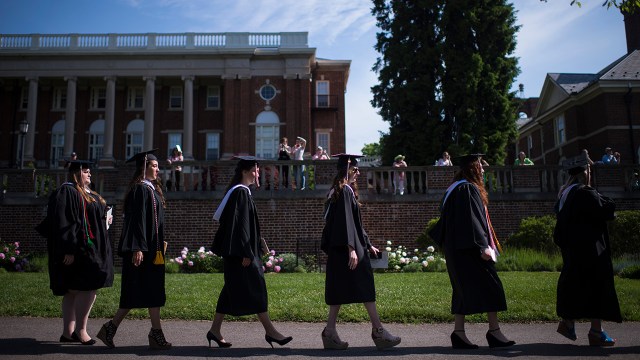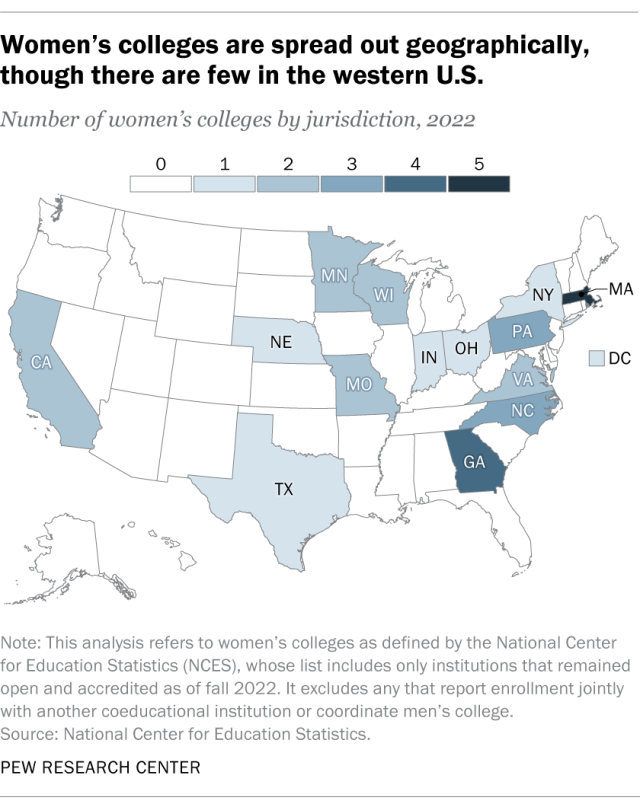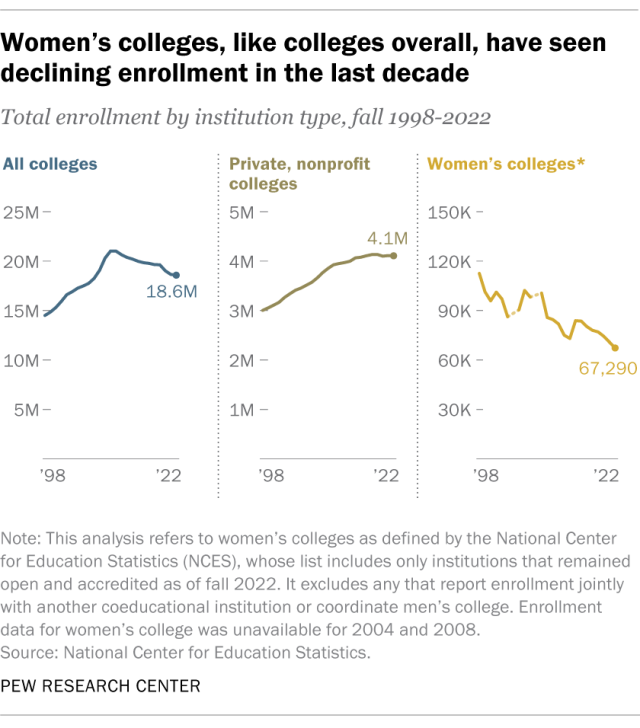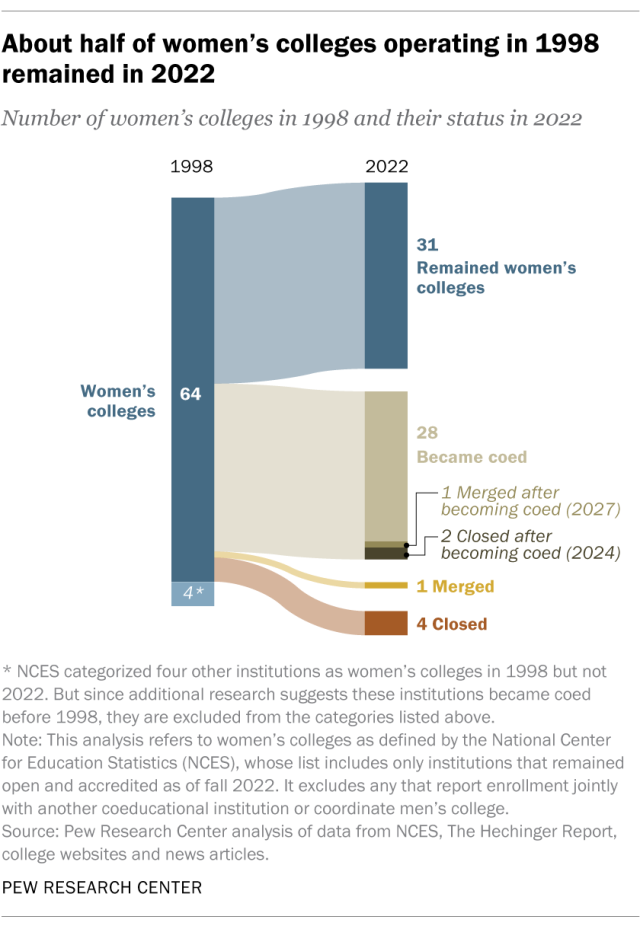
The number of women’s colleges in the United States has declined since the mid-20th century, a result of many becoming coeducational, merging with other institutions or simply closing their doors. While there were once over 200 women’s colleges in the U.S., there were just 31 as of fall 2022, according to the National Center for Education Statistics (NCES).
This trend isn’t limited to women’s colleges: An increasing number of colleges and universities have closed in the last decade. But falling enrollment at women’s colleges, even as more women than men are now college graduates, has renewed questions about the value of these institutions and who should be allowed to attend.
Here are answers to some key questions about women’s colleges, including how they admit students and how enrollment has changed in recent years.
What are women’s colleges?
There is no single definition of a women’s college, but most are institutes of higher education founded with a mission of educating women.
At many women’s colleges, current students primarily – though often not exclusively – identify as women. Some women’s colleges also offer specific coed programs or degrees. The list of women’s colleges used in this analysis comes from NCES. These records are primarily based on members of the Women’s College Coalition (WCC), an advocacy group that raises awareness of these institutions.
Women’s colleges in the U.S. date back to the mid-19th century, a time when women were not able to access many of the same educational institutions as men. Today, there are 31 women’s colleges in the U.S., two of which are also historically Black colleges or universities (HBCUs).
Many women’s colleges were founded with religious affiliations; at least 12 today retain religious ties, nine of which are Catholic. Women’s colleges tend to be private, nonprofit institutions with smaller student bodies. They often serve students who rely on financial aid.
Sometimes, women’s colleges are referred to as “historically women’s colleges” (HWCs). This term may be used to describe institutions that were once women’s colleges but have since become coed, or to be inclusive of transgender and nonbinary students who attend. This analysis uses the term “women’s colleges,” following the lead of NCES.
Where are women’s colleges located?

Unlike HBCUs, which are highly concentrated in the southern U.S., women’s colleges are somewhat more spread out across the country. Massachusetts has five women’s colleges, the most of any state. Georgia has four, including one historically Black women’s college (Spelman College). The other historically Black women’s college, Bennet College, is in North Carolina.
Related: A look at historically Black colleges and universities in the U.S.
How do admissions work at women’s colleges?
Admissions policies at women’s colleges differ depending on whether the institution is private or public.
Nearly all women’s colleges are private and can legally restrict admissions based on gender. Some private women’s colleges have allowed men to enroll in graduate or part-time programs, while still limiting their full-time undergraduate programs to women.
Texas Woman’s University (TWU) is the only public women’s college. Public institutions cannot reject qualified men on the basis of gender; the U.S. Supreme Court ruled in 1982 that this would violate the equal protection clause of the 14th Amendment. However, men made up just 12% of TWU’s total student body in fall 2022.
Women’s colleges also have varying policies regarding the admission of transgender students. Some women’s colleges deny admission to trans women. Others have expanded their admissions policies to include anyone who identifies as a woman, as nonbinary or as transgender.
How has enrollment in women’s colleges changed over time?

Most of the current women’s colleges had relatively small student bodies in fall 2022: 94% had fewer than 5,000 undergraduate and graduate students.
Since 1998, there has been a 40% decline in enrollment at women’s colleges, from about 112,500 students to about 67,300 by 2022. By comparison, enrollment at all colleges and at all private, nonprofit colleges has risen over this time span (by 28% and 37%, respectively).
More recently, overall college enrollment has declined, falling 10% between 2012 and 2022. The drop in enrollment at women’s colleges was even steeper – 18% over the same period.

Not all women’s colleges have felt this drop in enrollment equally, and some schools have even seen an increase in enrollment and applications. However, the overall decline coincides with the dissolution of many women’s colleges. Between 1998 and 2022, the status of about half of the nation’s existing women’s colleges changed:
- Four permanently closed their doors.
- One merged with another institution (Mills College was purchased by Northeastern University in 2022).
- Another 28 became coed, including two that went on to close after 2022 (Wells College and Notre Dame College of Ohio) and one that has announced plans to merge with a larger institution (Rosemont College will merge with Villanova University in 2027).
(NCES also categorized Carlow College, Marymount College, Marymount Manhattan College and Mississippi University For Women as women’s colleges in 1998 but not 2022. But since additional research suggests these institutions became coed before 1998, they are excluded from the categories listed above.)
Though colleges may close for a variety of reasons, enrollment has a major impact on these institutions’ financial health. This is especially true for smaller colleges, which women’s colleges often are.